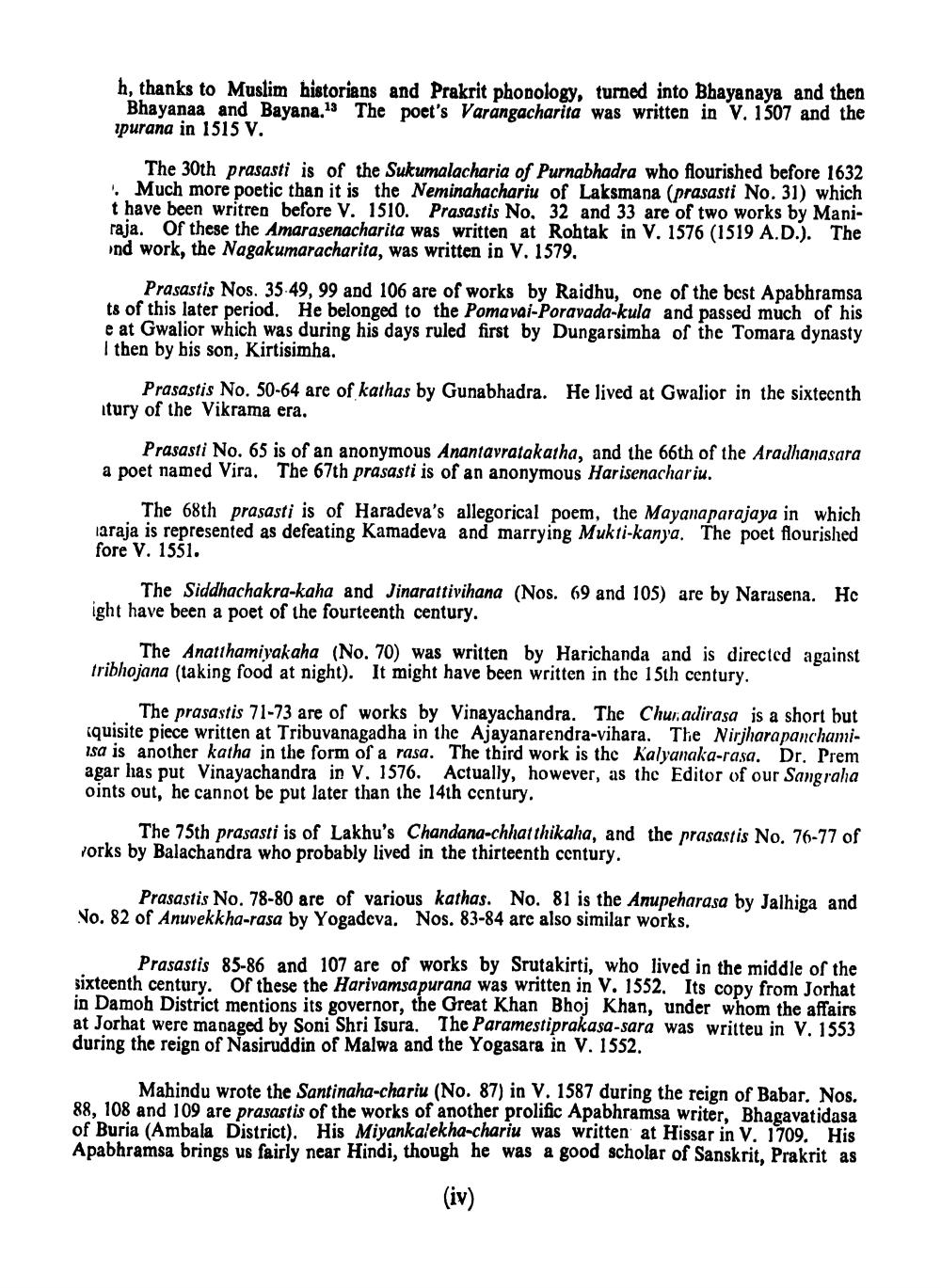________________
h, thanks to Muslim historians and Prakrit phonology, turned into Bhayanaya and then
Bhayanaa and Bayana.13 The poet's Varangacharita was written in V. 1507 and the purana in 1515 V.
The 30th prasasti is of the Sukumalacharia of Purnabhadra who flourished before 1632 ! Much more poetic than it is the Neminahachariu of Laksmana (prasasti No. 31) which t have been writren before V. 1510. Prasastis No. 32 and 33 are of two works by Maniraja. Of these the Amarasenacharita was written at Rohtak in V. 1576 (1519 A.D.). The ind work, the Nagakumaracharita, was written in V. 1579.
Nagakumarachariharita was written No: 32 and 33a na (prasasti No
Prasastis Nos. 35-49, 99 and 106 are of works by Raidhu, one of the best Apabhramsa ts of this later period. He belonged to the Pomavai-Poravada-kula and passed much of his e at Gwalior which was during his days ruled first by Dungarsimha of the Tomara dynasty I then by bis son, Kirtisimha.
Prasastis No. 50-64 are of kathas by Gunabhadra. He lived at Gwalior in the sixteenth tury of the Vikrama era.
Prasasti No. 65 is of an anonymous Anantavratakatha, and the 66th of the Aradhanasara a poet named Vira. The 67th prasasti is of an anonymous Harisenachariu.
The 68th prasasti is of Haradeva's allegorical poem, the Mayana parajaya in which laraja is represented as defeating Kamadeva and marrying Mukti-kanya. The poet flourished fore V. 1551.
The Siddhachakra-kaha and Jinarattivihana (Nos. 69 and 105) are by Narasena. Hc ight have been a poet of the fourteenth century.
The Anatihamiyakaha (No. 70) was written by Harichanda and is directed against tribhojana (taking food at night). It might have been written in the 15th century.
The prasastis 71-73 are of works by Vinayachandra. The Chu: adirasa is a short but quisite piece written at Tribuvanagadha in the Ajayanarendra-vihara. The Nirjharapanchami. isa is another katha in the form of a rasa. The third work is the Kalyanaka-rasa. Dr. Prem agar has put Vinayachandra in V. 1576. Actually, however, as the Editor of our Sangraha oints out, he cannot be put later than the 14th century.
The 75th prasasti is of Lakhu's Chandana-chhatthikaha, and the prasastis No. 76-77 of works by Balachandra who probably lived in the thirteenth century.
Prasastis No. 78-80 are of various kathas. No. 81 is the Anupeharasa by Jalhiga and No. 82 of Anuvekkha-rasa by Yogadeva. Nos. 83-84 are also similar works.
Prasastis 85-86 and 107 are of works by Srutakirti, who lived in the middle of the sixteenth century. Of these the Harivamsa purana was written in V. 1552. Its copy from Jorhat in Damoh District mentions its governor, the Great Khan Bhoj Khan, under whom the affairs at Jorhat were managed by Soni Shri Isura. The Paramestiprakasa-sara was writteu in V. 1553 during the reign of Nasiruddin of Malwa and the Yogasara in V. 1552.
Mahindu wrote the Santinaha-chariu (No. 87) in V. 1587 during the reign of Babar. Nos. 88, 108 and 109 are prasastis of the works of another prolific Apabhramsa writer, Bhagavatidasa of Buria (Ambala District). His Miyankalekha-chariu was written at Hissar in V. 1709. His Apabhramsa brings us fairly near Hindi, though he was a good scholar of Sanskrit, Prakrit as




